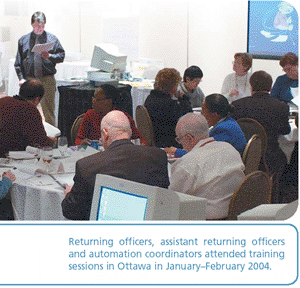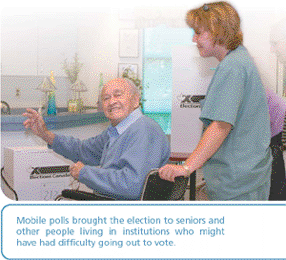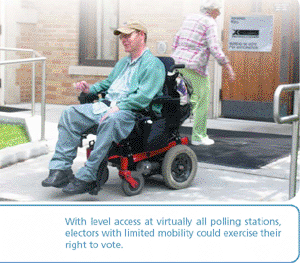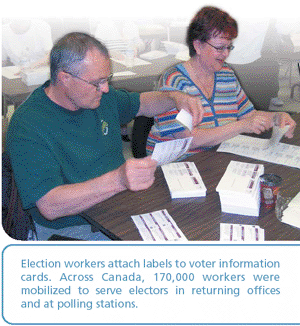Report of the Chief Electoral Officer of Canada
on the 38th General Election Held on June 28, 2004
Preparations in the electoral districts
Returning officers' duties
The duties of a returning officer are varied and call for the use of a wide range of modern management techniques: financial planning; material, human and financial resources management; contract negotiation; public relations; and office automation, to name a few. Returning officers must be both skilled and efficient to complete their tasks within the short periods of time allowed by the election calendar. A total of eight resigned after their training sessions in Ottawa.
Typically, a returning officer would supervise about 55 people in the returning office and about 574 people in the electoral district, and would manage a budget of approximately $350,000.
Each returning officer is required to attend an eight-day basic training session on the fundamentals of administering a federal election in his or her electoral district. When there is a by-election in an electoral district, the returning officer, assistant returning officer and the automation coordinator are required to participate at a training session in order to be brought up to date on the latest changes. Before a general election, returning officers, assistant returning officers and automation coordinators attend a mandatory three-day pre-event training session to ensure they are at the highest level of readiness.
Training in preparation for by-elections
The staff in the electoral districts involved in the by-elections needed to be kept up to date on the latest changes to systems and procedures. To introduce field staff to pilot projects, we held three-day briefings at Elections Canada for 12 returning officers and other staff members (usually the assistant returning officers and automation coordinators) in those ridings where seats in the House of Commons were vacant and by-elections were expected. After each by-election, we held one-day post-mortem sessions with the returning officer and assistant returning officer, and, depending on the subjects to be discussed, the automation coordinator, revision supervisor and special ballot coordinator.
Pre-event training for returning officers, assistant returning officers and automation coordinators
Returning officers (newly appointed or reappointed), their assistant returning officers and their automation coordinators – almost 872 people in all – attended comprehensive, three-day pre-event training sessions in January–February 2004. The training was based on adult learning principles, with the objective of ensuring the highest level of preparation for the event. Interactive training helped maximize retention.
For an environment conducive to learning, we made an effort to create homogeneous groups, respecting the individual characteristics of urban, rural and remote ridings. We also tried to keep the representatives of electoral districts from the same province together, both experienced staff and those new to their positions, along with their field liaison officers.
 The pre-event training required a massive effort on the part of Elections Canada.
Approximately 50 trainers came from nine different divisions of the organization.
The three-day training session consisted of 29 modules in both English and French.
People were scheduled six days a week, from Monday through Saturday, over a
period of five weeks, with six classes running simultaneously. Collectively,
the 872 persons received a total of 20,000 hours of training on our new
systems and on recent developments in electoral law and administration.
The pre-event training required a massive effort on the part of Elections Canada.
Approximately 50 trainers came from nine different divisions of the organization.
The three-day training session consisted of 29 modules in both English and French.
People were scheduled six days a week, from Monday through Saturday, over a
period of five weeks, with six classes running simultaneously. Collectively,
the 872 persons received a total of 20,000 hours of training on our new
systems and on recent developments in electoral law and administration.
On March 25, 2004, the Chief Electoral Officer appeared before the House of Commons Standing Committee on Procedure and House Affairs. He noted that Elections Canada had never before presented such professional training sessions.
Pre-event training – evaluation by participants
Following the pre-event training sessions, we reviewed thoroughly the evaluation summaries received from participants. For the training of returning officers and assistant returning officers, the success of our training program exceeded the participants' and our expectations. The overall score on the post-course evaluation was 85.5 percent, very high given the number of modules and the number of trainers over a six-week period.
The training program for automation coordinators comprised 32 modules in both English and French. The overall score on the post-course evaluation was 90 percent, once again exceeding expectations. This score was very high, considering the number of systems and procedures that were taught over a three-day period (hands-on training requires ample time for individuals to effectively experience the computer application).
Instructors were highly rated for their preparation and strong subject-matter expertise. The overall quality of instruction was rated high, at 92 percent. In addition, participants found that instructors were attentive to participant needs.
Returning offices and polling sites
The task of finding a suitable location for an office is not straightforward. Some of the challenges facing the returning officer are the requirements of accessibility for electors (including persons with disabilities) and the capacity of the building to accommodate the telecommunications and computer hook-ups, plus local availability, the very short rental periods and the reluctance of landlords to subscribe to standard form leases.
The Canada Elections Act requires returning officers to ensure level access in their offices, as well as outside and inside all polling places used during an election. To assist returning officers in evaluating the accessibility of polling sites, Elections Canada has developed material explaining what is necessary to make sites meet current standards.
Finding multiple locations to be used as polling sites is also challenging. Before the issue of the writs, the returning officers scout for suitable locations. Depending on population density, multiple polling stations may be grouped in a single location. Where feasible, polls were centrally located in a school, community centre or other easily accessible public building. Renting of such locations remains challenging, as arrangements must respect the interests of the school boards, community centre operators and other owners. Their co-operation contributed to the success of the election.
Returning officers set up 63,859 polls in 18,807 different polling sites (locations):
- 14,925 ordinary poll locations (59,514 polls)
- 2,702 advance poll locations (3,235 polls)
- 3,172 mobile poll locations (1,110 polls)
(Some locations were used for both advance voting and election day voting.)
Each ordinary poll served an average of 352 electors.
| Ordinary polls | ||
|---|---|---|
| Facility type | 2000 | 2004 |
| Apartment building | 2.7% | 2.4% |
| Band office | 0.3% | 0.2% |
| Church hall | 11.9% | 13.1% |
| Commercial site | 2.8% | 2.1% |
| Community centre | 25.6% | 25.7% |
| Educational facility | 41.3% | 40.1% |
| Federal building | 0.1% | 0.1% |
| Fire hall | 1.5% | 1.2% |
| Hospital | 0.4% | 0.2% |
| Municipal or township hall | 3.3% | 3.4% |
| Other | 2.2% | 3.3% |
| Post office | 0.0% | 0.0% |
| Private home | 0.0% | 0.1% |
| Recreation centre | 2.1% | 3.5% |
| Royal Canadian Legion | 1.9% | 1.5% |
| Seniors residence | 3.9% | 3.2% |
| Total | 100.0% | 100.0% |
| Advance polls | ||
|---|---|---|
| Facility type | 2000 | 2004 |
| Apartment building | 2.2% | 2.0% |
| Band office | 0.1% | 0.1% |
| Church hall | 17.2% | 17.1% |
| Commercial site | 4.9% | 5.7% |
| Community centre | 30.8% | 33.8% |
| Educational facility | 16.3% | 15.4% |
| Federal building | 0.2% | 0.2% |
| Fire hall | 2.6% | 1.5% |
| Hospital | 0.5% | 0.3% |
| Municipal or township hall | 7.0% | 8.0% |
| Other | 4.2% | 4.8% |
| Post office | 0.0% | 0.0% |
| Private home | 1.6% | 0.1% |
| Recreation centre | 3.1% | 4.5% |
| Royal Canadian Legion | 2.7% | 2.1% |
| Seniors residence | 6.6% | 4.3% |
| Total | 100.0% | 100.0% |
The most common locations for polling stations were community centres and educational facilities. As shown in Table 1, polling stations were also established in places as varied as hospitals, fire stations and Aboriginal band offices.
Mobile polls
 In addition to finding and renting appropriate locations for the advance and
regular polls, returning officers must make arrangements for mobile polls, which
serve electors who are seniors or persons with a physical disability, and who
reside in an institution. The poll moves from one institution to another so
that the electors in each location can vote conveniently at hours that are made
known well in advance of election day.
In addition to finding and renting appropriate locations for the advance and
regular polls, returning officers must make arrangements for mobile polls, which
serve electors who are seniors or persons with a physical disability, and who
reside in an institution. The poll moves from one institution to another so
that the electors in each location can vote conveniently at hours that are made
known well in advance of election day.
Throughout the country, 1,110 mobile polls serving 3,172 facilities were established in 274 electoral districts, to serve a population of 170,925 registered electors (see Table 2); in all, 92,091 electors voted at mobile polls.
| Province or territory | Number of mobile polling stations | Number of electors served |
|---|---|---|
| Newfoundland and Labrador | 24 | 2,790 |
| Prince Edward Island | 8 | 987 |
| Nova Scotia | 27 | 4,477 |
| New Brunswick | 51 | 7,078 |
| Quebec | 275 | 39,058 |
| Ontario | 313 | 56,518 |
| Manitoba | 54 | 7,823 |
| Saskatchewan | 51 | 7,641 |
| Alberta | 149 | 23,958 |
| British Columbia | 157 | 20,517 |
| Yukon | 1 | 78 |
| Northwest Territories | 0 | 0 |
| Nunavut | 0 | 0 |
| Total | 1,110 | 170,925 |
Level access
 Under exceptional circumstances, the Chief Electoral Officer may approve the
location of a polling station in premises without level access. Of the 18,807
polling sites used in the 38th general election, only 45 (0.2 percent)
did not provide level access, compared with 89 (0.5 percent) in the
37th general election. All voter information cards indicated whether the elector's
polling site was accessible. Transfer certificates were available up to June
25; they allowed electors with disabilities to use other polling stations with
level access if their own polling stations did not provide such access. Transfer
certificates were also used by poll workers.
Under exceptional circumstances, the Chief Electoral Officer may approve the
location of a polling station in premises without level access. Of the 18,807
polling sites used in the 38th general election, only 45 (0.2 percent)
did not provide level access, compared with 89 (0.5 percent) in the
37th general election. All voter information cards indicated whether the elector's
polling site was accessible. Transfer certificates were available up to June
25; they allowed electors with disabilities to use other polling stations with
level access if their own polling stations did not provide such access. Transfer
certificates were also used by poll workers.
We have modified buildings and offices used everywhere in Canada. By arranging to have ramps built, returning officers in 68 electoral districts modified 154 facilities to provide level access. The facilities served 25 advance polls and 813 ordinary polls.
Data on accessibility are collected in SITES, a software application that has maintained Elections Canada's national inventory of electoral facilities since 1991. The inventory helps to identify accessibility problem areas so that corrective measures can be taken in advance. For the first time, prior to this election, the application was made available to returning officers so that they could maintain their database from home during their pre-event assignment.
To avoid duplication across jurisdictions and to better serve the Canadian electorate, information on polling sites is shared with provincial and municipal election organizations.
Election officers and local staff
The returning officer is responsible for the appointment, training and supervision of election officers and election staff. Some election officers (deputy returning officers, poll clerks and revising agents) are selected in each electoral district from recommendations made by the registered parties whose candidates came first or second in the previous election in the electoral district, or by the candidates representing the registered political parties whose candidates came first or second. The remaining staff and election officers are selected by the returning officer. For revising agents, names must be submitted three days after the returning officer makes the request. For deputy returning officers, poll clerks and registration officers, names must be submitted by the 17th day before election day (June 11 for the 38th general election).
For the 38th general election, new electoral boundaries were in effect following the redistribution of 2003. In order to determine which political parties and candidates had the right to recommend election officers in this context, it was necessary that the votes obtained in the 37th general election be transposed to the new boundaries. The transposition of votes is an exercise that determines the number of votes that each registered political party at the 37th general election would have obtained in the electoral districts proclaimed in the 2003 Representation Order. The resulting information was recorded on CD-ROM and distributed on January 20, 2004, to all members of Parliament and to political parties. A summary was also posted on the Elections Canada Web site.
Notwithstanding the recommendations from candidates and parties, returning officers continue to have difficulties in hiring enough qualified election officers. Parties and candidates are not always able to provide enough recommendations to fill the positions available. This may be due partly to the fact that the parties and candidates have an increased need during an election event to draw on their network of human resources for their own campaign needs. The problem is sometimes compounded when people who have been trained for these positions do not appear for work on election day.
Contingency plans
Returning officers often face staff shortages. To give effect to the candidates' and parties' right to recommend election officers, the Canada Elections Act provides that the returning officer must wait until the 17th day before election day before going to other sources to fill staff positions. A new job application form posted on the Elections Canada Web site on May 27 helped returning officers fill part of the shortfall of staff within the time constraints.
 Contingency plans were developed by returning officers, in co-operation with
the field liaison officers, to ensure that all polling stations would open at
the time prescribed by the Canada Elections Act. The plan called for
training of stand-by workers to eliminate the risks associated with last-minute
resignations by election day officials. Nationally, an extra 6,510 officers
were available for election day; 2,209 extra election officers were available
for each day of advance voting.
Contingency plans were developed by returning officers, in co-operation with
the field liaison officers, to ensure that all polling stations would open at
the time prescribed by the Canada Elections Act. The plan called for
training of stand-by workers to eliminate the risks associated with last-minute
resignations by election day officials. Nationally, an extra 6,510 officers
were available for election day; 2,209 extra election officers were available
for each day of advance voting.
Notwithstanding the staffing challenges, 170,000 election workers were mobilized to serve electors in the returning offices during the election period and at polling stations (see Table 3).
Of the 308 returning officers, 91.9 percent submitted a contingency plan for the advance polls, and 90.9 percent submitted a contingency plan for election day.
| Election positions* | Number |
|---|---|
| Returning officer | 308 |
| Assistant returning officer | 308 |
| Additional assistant returning officer | 103 |
| Automation coordinator | 324 |
| Assistant automation coordinator | 328 |
| Community relations officer | 336 |
| Central poll supervisor – Stand-by | 260 |
| Central poll supervisor – Advance voting | 561 |
| Central poll supervisor – Ordinary poll | 8,410 |
| Deputy returning officer – Advance voting | 3,321 |
| Deputy returning officer – Correctional institution | 242 |
| Deputy returning officer – Mobile poll | 1,136 |
| Deputy returning officer – Ordinary poll | 59,697 |
| Deputy returning officer – Special ballot | 621 |
| Deputy returning officer on stand-by – Advance voting | 239 |
| Financial officer | 351 |
| Information officer – Advance voting | 1,287 |
| Information officer – Ordinary poll | 9,821 |
| Interpreter – Aboriginal Elder and Youth Program | 359 |
| Language interpreter – Advance voting | 6 |
| Language interpreter – Ordinary poll | 44 |
| Inventory control clerk | 641 |
| Office clerk | 6,225 |
| Office coordinator | 582 |
| Office messenger | 566 |
| Poll clerk – Advance voting | 3,692 |
| Poll clerk – Correctional institution | 199 |
| Poll clerk – Mobile poll | 1,126 |
| Poll clerk – Ordinary poll | 59,723 |
| Poll clerk – Special ballot | 566 |
| Receptionist | 1,020 |
| Recruitment officer | 538 |
| Registration officer – Ordinary poll | 11,753 |
| Registration officer – Stand-by | 143 |
| Registration officer – Advance voting | 1,977 |
| Revising agent | 12,965 |
| Revision centre clerk | 652 |
| Revision supervisor | 445 |
| Special ballot coordinator | 1,701 |
| Special messenger | 407 |
| Support staff for additional assistant returning officer | 20 |
| Training officer | 538 |
| Witness for validation of results | 195 |
| Total | 193,736 |
* With the exception of the positions of returning officer and assistant returning officer, all figures reflect the total number of election workers who filled a specific position during the election period. In some cases, more than one individual may have been hired to perform a certain task – for example, because of staff changes and job sharing. In total, approximately 170,000 workers were hired to fill the 193,736 positions.
The Elections Canada Support Network
To assist returning officers and their staff, the Elections Canada Support Network was set up in Ottawa, with five help desks: Electoral Coordination, Revision Systems (including Information Technology), Special Voting Rules, Finance, and Support Services. Returning officers and their staff could contact the support network by telephone, e-mail or fax, or by forwarding a request through a computerized call-tracking system. Three levels of expertise (approximately 120 advisors) were available for consultation for 18 hours a day from Monday to Friday, 16 hours on Saturdays, and 9.5 hours on Sundays. A total of 82,158 queries were made during the election, of which 76,492 were answered immediately, yielding a response rate of 93 percent (that is, 8 percent above the general service standard of 85 percent). The remaining 7 percent of calls received a busy signal or else the caller disconnected while waiting to speak to an agent. The support network answered an average of 2,067 queries a day, an increase of 543 calls per day over the previous general election average. The greatest number of queries was received on May 28 (the 31st day before election day): 4,437 calls, with a response rate of 60 percent in the first 18 seconds.
After the election, office staff and election officers could call a toll-free number for answers to questions about payments and earning records. From initiation of the service through late September 2004, some 30,000 calls were received from election workers.
Figure 1 :
Calls to Elections Canada Support Network from returning offices – 38th general election, 2004

Click on the graph above to view a larger version.
